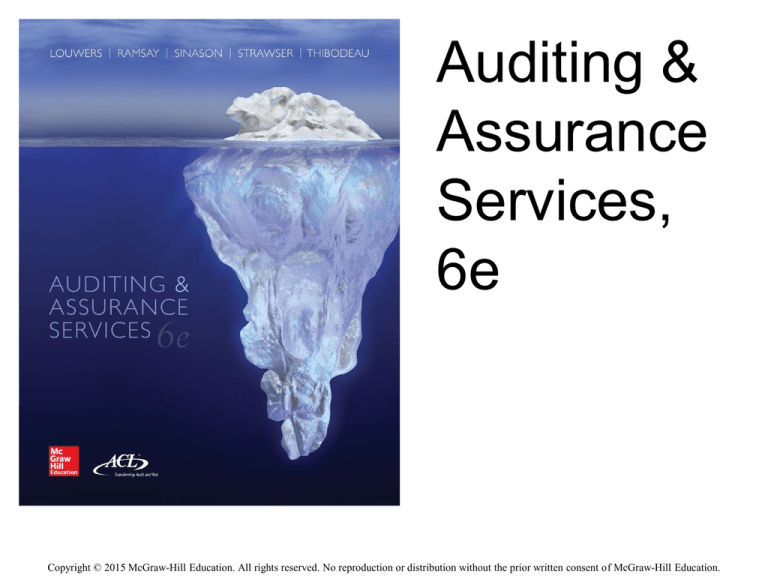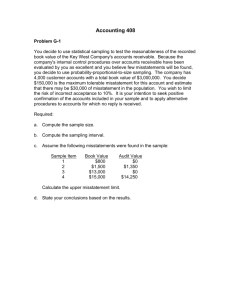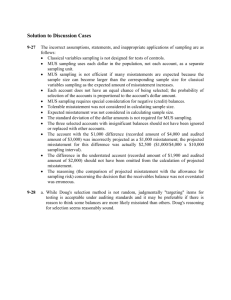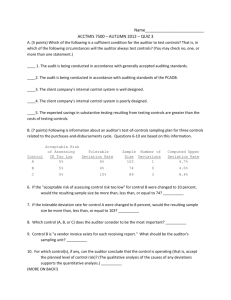
Auditing &
Assurance
Services,
6e
Copyright © 2015 McGraw-Hill Education. All rights reserved. No reproduction or distribution without the prior written consent of McGraw-Hill Education.
Module G
Variables Sampling
USA Today has come out with a new survey – apparently, three
out of every four people make up 75 percent of the population.
David Letterman, American comedian and television host
Mod G-2
Module G Objectives
1.
Define variables sampling and understand when it is used in the audit.
2.
Understand the basic process underlying monetary unit sampling
(MUS) and when to use it.
3.
Identify the factors affecting the size of an MUS sample and calculate
the sample size for an MUS application.
4.
Evaluate the sample results for an MUS by calculating the projected
misstatement, incremental allowance for sampling risk, and basic
allowance for sampling risk.
5.
Understand the basic process underlying classical variables sampling
and the use of classical variables sampling in the audit.
6.
Understand the use of nonstatistical sampling for variables sampling.
Mod G-3
Variables Sampling
• Variables sampling is used to estimate the amount (or value) of
a population
• Substantive procedures
– Estimate account balance or misstatement
– Compare estimated account balance or misstatement to recorded
amount or tolerable misstatement
• Approaches
– Monetary unit sampling (MUS)
– Classical variables sampling
Mod G-4
Major Topics
I.
Monetary Unit Sampling (MUS)
− Basics of MUS
− Determining Sample Size
− Selecting and Measuring Sample Items
− Evaluating Sample Results
II. Classical Variables Sampling
III. Nonstatistical Sampling
Mod G-5
Monetary Unit Sampling
(MUS)
• Defines the sampling unit as an individual dollar (or
other monetary unit) in an account balance
• Auditor will select individual dollars (or monetary
units) for examination
• Auditor will verify the entire “logical unit”
containing the selected dollar (or monetary unit)
– Accounts receivable: Customer account
– Inventory: Inventory item
Mod G-6
Advantages of MUS
• Results in more efficient (smaller) sample sizes
• Selects transactions or components reflecting
larger dollar amounts
• Effective in identifying overstatement errors
– Asset and revenue accounts
• Generally simpler to use than classical
variables sampling
Mod G-7
Disadvantages of MUS
• Provides a conservative (higher) estimate of
misstatement
• Not effective for understatement or omission errors
– Liabilities and expenses
• Expanding sample is difficult if initial conclusion is
to reject the account balance
• Requires special consideration for accounts with
zero or negative balances
Mod G-8
Major Topics
I.
Monetary Unit Sampling (MUS)
− Basics of MUS
− Determining Sample Size
− Selecting and Measuring Sample Items
− Evaluating Sample Results
II. Classical Variables Sampling
III. Nonstatistical Sampling
Mod G-9
Effect of Factors on Sample
Size
Factor
Effect
How Determined
Sampling risk (risk of incorrect
acceptance)
Inverse
Using the audit risk model and based on prior
assessments of audit risk, risk of material
misstatement, and analytical procedures risk
Tolerable misstatement
Inverse
Based on recorded account balance and
relationship between the recorded account
balance and important financial statement
subtotals
Expected misstatement
Direct
Based on prior experience with the client (for
recurring audits) or a pilot sample (for initial
audits)
Population size
Direct
Based on the recorded balance in the account
balance or class of transactions
Mod G-10
Summary: Sampling Risks
Under Variables Sampling
Decision Based on Population
Decision
Based on
Sample
Account is not
misstated
(AM ≤ TM)
Account is misstated
(AM > TM)
Account is not
misstated
(ULM ≤ TM)
Correct decision
Risk of incorrect
acceptance
Account is
misstated
(ULM > TM)
Risk of incorrect
rejection
Correct decision
AM
TM
ULM
= Actual misstatement
= Tolerable misstatement
= Upper limit on misstatements
Mod G-11
Using MUS Tables
• See Exhibit G.2 for Sample Size Table
• Inputs
– Risk of incorrect acceptance
– Expected misstatement
– Tolerable misstatement
– Population size
Mod G-12
Example
• Parameters
– Risk of incorrect acceptance = 5%
– Expected misstatement = $100,000
– Tolerable misstatement = $500,000
– Population size = $1,000,000
• Calculations
– Ratio of expected to tolerable misstatement: $100,000 ÷ $500,000 = 0.20
– Tolerable misstatement as a percentage of population: $500,000 ÷
$1,000,000 = 50%
Mod G-13
Step 3: Select column for TM as % of
population = 50%
Step 1: Select entries for risk
of incorrect acceptance = 5%
Risk of
Ratio of
incorrect
Expected to
acceptance Tolerable
Misstatement
Tolerable Misstatement as a Percentage of
Population
50%
30%
10%
8%
5%
-
6
10
30
38
5%
0.10
8
13
37
46
5%
0.20
10
16
47
58
5%
0.30
12
20
60
75
5%
0.40
17
27
81
102
Step 2: Select row for ratio
of EM to TM = 0.20
Step 4: Read sample
size at junction of row
and column
Mod G-14
Major Topics
I.
Monetary Unit Sampling (MUS)
− Basics of MUS
− Determining Sample Size
− Selecting and Measuring Sample Items
− Evaluating Sample Results
II. Classical Variables Sampling
III. Nonstatistical Sampling
Mod G-15
MUS: Selecting Sample Items
• Use systematic random sampling
• Calculate sampling interval as:
Population size ÷ Sample size
• Process
– Identify random start
– Skip number of items equal to sampling interval
– Select item (dollar in account) and examine entire logical
unit containing that item (customer account)
– May select same logical unit multiple times
Mod G-16
MUS: Measuring Sample
Items
Mod G-17
Major Topics
I.
Monetary Unit Sampling (MUS)
− Basics of MUS
− Determining Sample Size
− Selecting and Measuring Sample Items
− Evaluating Sample Results
II. Classical Variables Sampling
III. Nonstatistical Sampling
Mod G-18
MUS: Evaluating Sample
Results
• Determine the upper limit on misstatements,
which has a (1 – Risk of incorrect acceptance) of
equaling or exceeding the true amount of
misstatement
• Components:
– Projected misstatement
– Incremental allowance for sampling risk
– Basic allowance for sampling risk
Mod G-19
Projected Misstatement
• Assumes entire sampling interval contains same
percentage of misstatement as the logical unit
examined by auditors
• Calculated for each misstatement as:
Sampling interval x Tainting %
• Do not project misstatements if the logical unit >
sampling interval
Mod G-20
Incremental Allowance for
Sampling Risk
• Adjusts the projected misstatement to control exposure to risk of
incorrect acceptance
• Allows for the possibility that the remainder of the sampling
interval might be misstated by a higher percentage than the
logical unit
• Procedure:
– Rank all projected misstatements in descending order
– Determine incremental confidence factor for each misstatement
– Multiply projected misstatement by (incremental confidence factor – 1)
Mod G-21
Basic Allowance for Sampling
Risk
• Provides a measure of the misstatement that might
exist in sampling intervals in which a misstatement
was not detected
• Calculated as:
Sampling interval x Confidence factor
Mod G-22
MUS: Evaluating Sample
Results
1
Projected Misstatement
2
Incremental allowance for sampling risk
XX,XXX
3
Basic allowance for sampling risk
XX,XXX
Upper limit on misstatements
$ XX,XXX
$XXX,XXX
Mod G-23
Upper Limit on
Misstatements
• If ULM = $50,000 and risk of incorrect
acceptance = 5%
$50,000
$0
95% probability (1 – risk of incorrect
acceptance)
5% probability (risk of
incorrect acceptance)
Mod G-24
MUS: Making the Decision
Upper Limit on
Misstatement
Upper Limit on
Misstatement
≤
>
Tolerable
Misstatement
Tolerable
Misstatement
Account
balance is
not
misstated
Account
balance is
misstated
Mod G-25
Decisions under MUS
• Account balance is not misstated
– Suggest correction of identified misstatements
– Investigate cause of misstatements
• Account balance is misstated
– Increase sample size to attempt and reduce upper limit
on misstatements
– Recommend adjustment to reduce misstatement below
tolerable misstatement
Mod G-26
Major Topics
I.
Monetary Unit Sampling (MUS)
− Basics of MUS
− Determining Sample Size
− Selecting and Measuring Sample Items
− Evaluating Sample Results
II. Classical Variables Sampling
III. Nonstatistical Sampling
Mod G-27
Classical Variables Sampling
• Uses normal distribution theory and the central limit
theorem to provide an estimated range of
– Recorded account balance or class of transactions
– Misstatement in an account balance or class of transactions
• Basic methodology
– Determine estimated range of account balance or
misstatement
– Evaluate using tolerable misstatement
Mod G-28
Additional Considerations in
Classical Variables Sampling
• Consider the following additional factors in
determining sample size
– Risk of incorrect rejection
– Population variability
• To reduce population variability, auditors
may choose to stratify the population
Mod G-29
Example
• Assume
– Recorded balance = $300,000
– Tolerable misstatement = $10,000
– Estimated balance = $292,500
– Precision = $2,275
– Risk of incorrect acceptance = 10%
– Risk of incorrect rejection = 15%
Mod G-30
Example (continued)
• Estimate ± Precision
$292,500 ± $2,275 = $290,225 to $294,775
$290,225
$294,775
$300,000
90% probability of including true
recorded balance
Difference between recorded balance and far end of interval <
Tolerable misstatement
Mod G-31
Classical Variables Sampling
Approaches
•
•
•
Mean-per-unit:
–
Assumes each item in population (component of account) has similar balance
–
Estimates recorded balance by multiplying number of components by average audited value
Difference estimation:
–
Assumes each item in population (component of account) has similar difference between
recorded and audited value
–
Estimates the amount of misstatement by multiplying number of components by average
misstatement
–
Estimates recorded balance using estimated misstatement
Ratio estimation:
–
Assumes a constant percentage misstatement in population
–
Estimates recorded balance by multiplying recorded balance by ratio of audited value to
recorded balance
Mod G-32
Sampling Methods
MUS
Classical Variables Sampling
Overstatement errors are greatest
concern
Both overstatement and
understatement errors are of concern
Standard deviation difficult to estimate
Standard deviation can be estimated
Smaller number of misstatements
anticipated
Larger number of misstatements
anticipated
Population has high degree of
variability and large dollar components
exist
Population is homogenous (in terms of
dollar balances) and large dollar
components do not exist
Mod G-33
Major Topics
I.
Monetary Unit Sampling (MUS)
− Basics of MUS
− Determining Sample Size
− Selecting and Measuring Sample Items
− Evaluating Sample Results
II. Classical Variables Sampling
III. Nonstatistical Sampling
Mod G-34
Nonstatistical Sampling
• Permissible under GAAS
• Does not permit auditors to control
exposure to sampling risk
• Major differences in:
– Determining sample size
– Selecting sample items
– Evaluating sample results
Mod G-35










